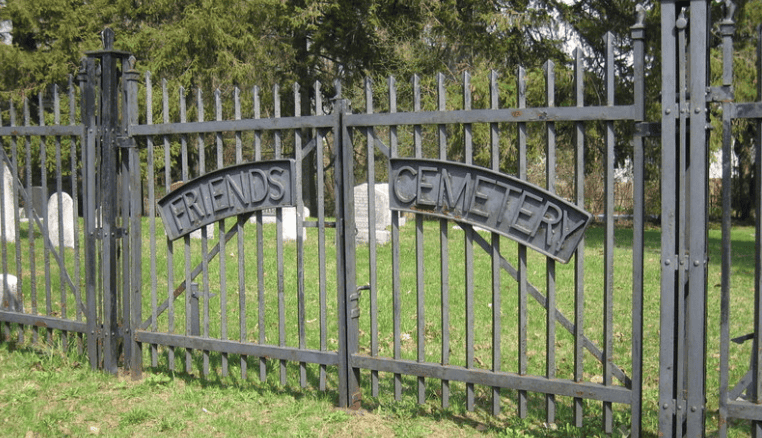Ajax cemetery holding Pickering Village’s earliest founders hosts tour
Published September 20, 2024 at 1:32 pm

The Town of Ajax is embracing the upcoming spooky season with a guided tour of one of its oldest cemeteries.
The tour is held at the Society of Friends Cemetery in historic Pickering Village on September 29. The cemetery was established in 1814 to support the Society of Friends (better known as Quakers) who had earlier settled in the town.
Settler Timothy Rogers led the settlements of what is now Pickering Village, as well as Newmarket. Rogers was born out of wedlock in 1756 in Connecticut Colony and raised as an orphan in poverty. He later joined the Quakers and pioneered several farms in New York and Vermont.
By the mid-1790s, he and his wife came to Canada, stopping in Nova Scotia before heading west. Their move to Canada came amid a wave of Quaker migration due to discrimination they faced in America after the revolution.
The couple arrived on Yonge Street in the dead of winter 1800, legend tells. There they founded what is now Newmarket (as opposed to York’s ‘Old Market’).
In 1809, Rogers headed to Duffins Creek to start a second settlement. The Wyandot (or Hurons) occupied the area at least 1525 having built a 2,000-person community there now dubbed the ‘Draper Site.’ This community later moved closer to Stouffville (the Mantle site) in the 1600s.
More than century later, England took over Upper Canada following the Seven Years War. Over the next 20-odd years various early European settlers came to the area, including Mike Duffin.
However, it wasn’t until Rogers’ arrival that there was a large European village. He brought around 180 people to the banks of Duffins Creek and built the area’s first sawmills and gristmill.
The village’s early days were quickly disrupted as many in town would soon be forced to defend their new home from their old one.
War broke out between British Canada and the United States in 1812. While much of the fighting took place in the Niagara and Hamilton areas, American forces were able to take and burn York (now Toronto) later in the conflict.
By this time, fellow Pickering Village area Quaker Jabez Lynde was pulled into the conflict. Lynde was born in Massachusetts but settled in Whitby. Lynde later bought a house in what is now Whitby as one of the town’s first settlers. By 1806, Lynde had become the “pathmaster” of both Pickering and Whitby. (Ajax would not be founded until the Second World War.) In this role, he was responsible for maintaining the towns’ roads.
He also ran an inn and tavern in Whitby which came to be a major stop for Canadian forces moving between Kingston and York. General Isaac Brock, who would later die in the conflict, visited Lynde House in February 1812. Brock was shot dead in the Battle of Queenston Heights that fall.
Lynde was then conscripted as a private sent to defend York. However, after the Americans sacked the city, Canadian forces retreated back to Kingston, raiding Lynde’s inn of all his beer and food on the way home.
Despite heavy losses, Canadian forces pushed the Americans back and ultimately sacked Washington D.C. to avenge York. By the end of 1814, the British and American governments negotiated a peace agreement in Belgium which largely returned everything (except for Lynde’s beer and food) to the pre-war status quo.
Lynde rebuilt the house after the war in a Georgian style. It has since been registered as a heritage site and hosts a museum. The family joined with Rogers’ Quakers and left the tavern business, likely because Quakers don’t drink.
In the mid-1800s the Quakers endured a major theological rift led by Elias Hicks. While more Orthodox Quakers tended to be wealthier and more urban, the Hicksites were largely poorer and more rural. The Hicksites accused the Orthodox branch of sacrificing their spiritual purity for economic success. The Lyndes left the Orthodox side and joined the Hicksites.
By then, Rogers had founded the Friends Cemetary. Both he and Lynde are buried there. However, early on Quakers did not mark their graves so Rogers does not have a headstone. Lynde does though, which will soon be honoured by the Graveside Project for his service in the War of 1812.
Much later, Pickering Village became part of Ajax. Rogers’ descendants eventually founded the Rogers telecommunications company, which they still run despite recent power struggles.
These stories and more will be shared in depth during the upcoming cemetary tour on September 29. During two walks at 11 a.m. and 1 p.m. the guide will take participants through the cemetery.
“During this tour you will be introduced to several Quaker families as we share their stories,” the town wrote, “their contributions, their struggles and how their Quaker faith influenced their traditions in worship, burial and conflict.”
INdurham's Editorial Standards and Policies





